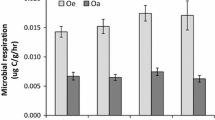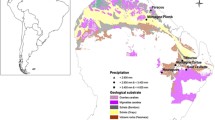Abstract
The extremely low nutrient-status of various recently afforested moor soils, particularly Yorkshire (England)Calluna soils, raised the question of their ability to provide the possible nutrient-demands of continuous forest growth. This paper describes how, for calcium, potassium and phosphorus, uptake estimates have been calculated from existing nutrient-composition data, and discusses the silvicultural significance of such estimates, particularly in relation to nutrient-poor soils.
All existing nutrient-composition data for whole individual mature temperate forest trees are summarized: using yield-data and a method of calculation critically discussed, they are made to provide nutrient-uptake estimates for one acre of such forest after periods of 50 and 100 years' growth. Mean estimates representing “hardwood,” “other conifer” and “pine” forest are then calculated showing: — the nutrients removed from the site via the various components of the timber-thinnings and clear-fellings, the nutrients taken up and immobilized within the various component organs of the growing forest, and the total nutrient-uptake from the site.
The estimates show that timber exploited forest, by reason of its unavoidable continuous nutrient-removal from the site, differs fundamentally from unexploited virgin forest; in absolute terms this removal may be small, but its pedological and silvicultural importance upon any particular site, depends entirely upon the ability of the soil to replenish this loss. It is believed that up to now the failure to recognize this nutrient-removal upon nutrient-poor soils has diverted attention from an important factor initiating both soil-degradation and diminishing site-productivity.
Soil nutrient-data presented show that the nutrient-uptakes of timber-producing forest of either confierous or hardwood species are so large compared with the nutrient-contents of moor soils that further overall soil-degradation and, sooner or later, diminished site-productivity are inevitable.
Upon such soils, therefore, continuous timber production cannot be sustained by ploughing or by the growth of hardwoods alone; new silvicultural techniques are needed which can restore to the site, by means of suitable soil-ameliorants and methods yet to be evolved, the nutrients continually being removed via the timber.
The paucity of knowledge concerning both the nutrient-demands of common tree species and the nutrient-status of the nutrient-poor soils upon which they are being extensively planted calls for an expansion of research upon these aspects if timber-production in this country is to be placed on a scientific, and not speculative, basis.
Similar content being viewed by others
Literature cited
Aaltonen, V. T., The characteristics of podzols. Commun. Inst. For. Fenn.27, 1–133 (1939).
Aaltonen, V. T., Die Blattanalyse als Bonitierungsgrundlage des Waldbodens. Comm. Inst. For. Fenn.37 (8) (1950).
Alten, F. and Doehring, W., Fertilizers in forest management. Z. Pflanzenernähr. Düng. u. Bodenk.59, 145–7 (1952).
Anderson, M. S. and Byers, H. C., Character of the colloidal materials in the profiles of certain major soil groups. U.S. Dept. Agr. Tech. Bull. No. 228 (1931).
Anon., The results of manuring trials with basic slag (and natural phosphatic chalk) on spruce during a period of 44 years at Sart-lez-Spa. Belgium. Service Agronomiques des Producteurs Belges et Luxembourgeois de Phosphate. 47 Cantersteen, Brussels (1953).
Arnon, D. I., Mineral nutrition of plants. Ann. Rev. Biochem.12, 499 (1943).
Bartholomew, W. V., Meyer, J. and Laudelout, H., Mineral nutrient immobilization under forest and grass fallow in the Yangambi (Belgian Congo) Region. Publ. Inst. Nat. Étude Agron. Congo Belge, Serie sci. No. 57, 27 pp. (1953).
Becker-Dillingen, J., Die Ernährung des Waldes. Handbuch der Forstdüngung, Berlin (1939).
Biswas, T. D., Distribution of manganese in profiles of some Indian soils. J. Indian Soc. Soil. Sci.1, 21–31 (1953).
Boresch, K., The mineral content of plants. Tabul. biol., Hague12 (4), 136–191; 315–353 (1936).
Burger, H., Experiments on soil improvement. III. Mitt. schweiz. Zentr. Anst. forstl. Versuchsw.28, 11–87 (1952).
Burges, A. and Drover, D. P., The rate of podzol development in sands of the Woy Woy District, N.S.W. Australian J. Botany1, 83–94 (1953).
Cain, J. C., The absorption and distribution of mineral nutrients in apple trees as affected by nutrient supply. Am. Soc. Hort. Sci. Proc.62, 53–66 (1953).
Camp, A. F. and Peech, M., Manganese deficiency in citrus in Florida. Am. Soc. Hort. Sci. Proc.36, 81–85 (1938).
Clarke, F. W., The Data of Geochemistry. U.S. Geol. Survey Bull. No. 770, 841 pp. Washington (1924).
Councler, C., Über den Gehalt dreier auf gleichem Boden erwachsener Nadelbäume, Tanne, Fichte und Lärche, an Trockensubstanz, Stickstoff und Mineralstoffen. Z. Forst- u. Jagdw.18, 353–375, 417–441 (1886).
Dimbleby, G. W., The historical status of moorland in North-East Yorkshire. New Phytologist51, 349–354 (1952).
Dimbleby, G. W., Soil regeneration on the North-East Yorkshire moors. J. Ecol.40, 331–341 (1952).
Ebermayer, E., Die gesammte Lehre der Waldstreu mit Rücksicht auf die chemische Statik des Waldbaues (p. 112). J. Springer, Berlin (1876).
Erteld, W., Wachstum und Ertrag der Robinie im Gebiet der Deutschen Demokratischen Republik. Dissertation, Eberswalde (1952).
Gardner, R. A. and Bradshaw, K. E., Characteristics and vegetation relationships of some podzolic soils near the coast of N. California. Soil Sci. Soc. Amer. Proc.18, 320–325 (1954).
Gaumann, E., Der Stoffhaushalt der Buche (Fagus silvatica, L.) im Laufe eines Jahres. Ber. schweiz. botan. Ges.44, 157–334 (1935).
Gaussen, R. H., Bericht über einige Kalkungsversuche in den Forstämtern Altenbecken und Neuenheerse. Forstarchiv14, 73–84 (1938).
Grandeau, L., Le sol des landes et des dunes et la végétation du pin maritime. Ann. Sta. Agron. de l'Est 1878, 353–369 (1878).
Grandeau, L. and Fliche, P., De l'influence de la composition chimique du sol sur la végétation du pin maritime (Pinus pinaster, Soland). Ann. Sta. Agron. de l'Est 1878, 3–39 (1878).
Henry, E., Étude chimique sur les essences principales de la forêt de Haye et sur leurs cendres. Ann. Sta. Agron. de l'Est 1878, 117–144 (1878).
Heyer, G. and Vonhausen, Ann. Chem. Pharm.82, 180 (1852) (only the abstract in Wolff, 1871, seen).
Jacks, G. V., A study of some Yorkshire moorland soils. Forestry6, 27–39 (1932).
Kalela, E. K., On the horizontal roots in pine and spruce stands. I. Acta For. Fenn.57 (2), 1–79 (1949).
Kellogg, C. E. and Nygard, I. J., The principal soil groups of Alaska. U.S. Dept. Agr., Agr. Monograph No. 7 (1951).
Köhler, A., The comparative success of conifer plantations in a forest range in N. Hesse. Allgem. Forst- u. Jagdztg.124, 215–8 (1953).
Leiningen, W., Forstwirtschaftliche Bodenbearbeitung, Düngung, und Einwirkung der Waldvegetation auf den Boden. Blanck's Handbuch der Bodenlehre9, 348–496 (1931).
Lohwasser, W., Kalkdüngungsversuche im Eggegebirge und Hunsrück, Ertragskundliche Untersuchungen. Forstarchiv24, 213–22 (1953).
Lunt, H. A., Profile characteristics of New England forest soils. Connecticut Agr. Exp. Sta. Bull. No. 342 (1932).
Lutz, H. J. and Chandler, R. F., Forest Soils. J. Wiley, New York (1946).
Lyford, W. H., The palatability of freshly fallen forest tree leaves to Millepeds. Ecology24, 252–261 (1943).
Molchanov, A. A., The reserves of needles in pine trees in timber stands of different ages. Doklady Akad. Nauk. SSR.67, 909–12 (1949) (U.S. Forest Service Translation No. 374, Dept. Agriculture, Washington).
Müller, P. E., Forest soil studies; A contribution to silvicultural theory. Tidsskr. Skovbrug Copenhagen3, 1 (1879).
Müller, P. E., Forest soil studies: On mull and mor in oak-forests and on heaths with some physical and chemical investigations of forest and health soils by C. F. A. Tuxen. Tidsskr. Skovbrug Copenhagen7, 1 (1884).
Muir, A., The soils of the Teindland state forest. Forestry8, 25–55 (1934).
Muir, A. and Fraser, G. K., The soils and vegetation of the Bin and Clashindarroch forests. Trans. Roy. Soc. Edinburgh60 Part I, 233–341 (1940).
Murphy, P. W., The biology of forest soils with special reference to the mesofauna or meiofauna. J. Soil Sic.4, 155–193 (1953).
Nemec, A., The biochemistry of forest-trees, chemical composition of organs. Publikace Ministersiva Zemedelstvi R.O.S. No. 120, Prague (1948).
Nemec, A., Types of forest soils, (The amelioration of podzols). Statni Zemedelske Nakladatelstvi, Prague (1954).
Nielson, R. L., Effect of soil minerals on earthworms. New Zealand J. Agr.83, 433–5 (1951).
Ogg, W. G., The Soils of Scotland, Part II, The north-eastern region. Emp. J. Exp. Agr.3, 248–260 (1935).
Ogg, W. G., The Soils of Scotland, Part III, The central valley and southern uplands. Emp. J. Exp. Agr.3, 295–312 (1935).
Ovington, J. D., Studies of the development of woodland conditions under different trees. I. Soils pH. J. Ecol.41, 13–34 (1953).
Peech, M. and Young, T. W., Chemical Studies on soils from Florida citrus groves. Florida Agr. Exp. Sta. Bull. No. 448, 6–84 (1948).
Ramann, E, Beiträge zur Statik des Waldbaues I Die Kiefer. Z. Forst-u. Jagdw.13, 417–433 (1881).
Ramann, E., Beiträge zur Statik des Waldbaues. 5. Die wilde Acazie (Robinia pseudo-acacia, L.). Z. Forst- u. Jagdw.15, 90–99 (1883).
Ramann, E. and Will, H., Beiträge zur Statik des Waldbaues. 2. Die Schwarzerle (Alnus glutinosa, Gaert.). Z. Forst- u. Jagdw.14, 54–64 (1882).
Ramann, E. and Will, H., Beiträge zur Statik des Waldbaues. 3. Die Weymouthskiefer (Pinus strobus, L.). Z. Forst- u. Jagdw.14, 350–358 (1882).
Ramann, E. and Will, H., Beiträge zur Statik des Waldbaues. 4. Die Hainbuche (Carpinus betulus, L.). Z. Forst- u. Jagdw.14, 497–504 (1882).
Ramann, E. and Will, H., Beiträge zur Statik des Waldbaues. 6. Die Esche (Fraxinus excelsior, L.). Z. Forst- u. Jagdw.15, 244–251 (1883).
Rennie, P. J., Unpublished data (1954).
Rode, A. A. in Joffe, J. S., Pedology. Rutgers Univ. Press, New Brunswick U.S.A. (1949).
Romell, L. G., Tree growth on acid soil. Nature (London)174, 855–7 (1954).
Russell, E. W., Soil Conditions and Plant Growth. Longmans, Green, London (1950).
Salisbury, E. J., Note on the edaphic succession in some dune soils with special reference to the time factor. J. Ecol.13, 322–8 (1925).
Schneider, B., Experience with liming and green-manuring on podzolised forest soils. Forstarchiv23, 153–8 (1952).
Schröder, J., Untersuchung der chemischen Constitution des Frühjahrsfastes der Birke, ein Preisschrift. Arch. Naturk. Liv-, Esth- u. Kurlands. Ser. 2.7, 1 (1865) (only the abstract in Wolff, 1871, seen).
Schröder, J., Zur Kenntniss des Mineralstoffgehaltes der Fichte. Tharandt forstl. Jahrb.24, 257–277 (1874).
Schröder, J., Forstchemische u. pflanzenphysiologische Untersuchungen, I, K. Schönfeld. Dresden (1878).
Schwappach, Ertragstafeln der wichtigeren Holzarten. J. Neumann, Neudamm (1912).
Simonart, P. and Huygh, A., The microbiological determination of copper in Campine soils. Agricultura (Louvain)1, 52–75 (1953).
Stewart, A. B., The genesis and development of two profiles in a drift soil in North-East Scotland. J. Agr. Sci.23, 73–96 (1933).
Tamm, O., Northern Coniferous Forest Soils (translated from the Swedish by M. L. Anderson). The Scrivener Press, Oxford (1950).
Tasselli, E., Ricerche chimico-forestali sulla Quercia Sughero. Staz. sper. agrar. ital.32, 209–32 (1899).
Vanselow, K., Krone und Zuwachs der Fichte in gleichaltrigen Reinbeständen. Forst-wiss. Cbl.70, 705–719 (1951).
Vincent, G. and Spalek, V., Poplars, their silviculture, timber properties and yield. Lesn. Knivhovna (mala Rada) No. 35, Prague (1954).
Viro, P. J., Fertilization trials on forest soil. Comm. Inst. For. Fenn.37 (7), 23 pp. (1950).
Viro, P. J., Nutrient status and fertility of forest soil. I. Pine stands. Commun. Inst. For. Fenn.39 (4), 1–54 (1951).
Warington, R., The Chemistry of the Farm, 9th edn. Vinton, London (1886).
Weber, R., Forstliche Blätter, 257 (only the abstract in Wolff, 1880 seen) (1876).
Weber, R., Vergleichende Untersuchungen über die Ausprüche der Weisstanne und Fichte an die mineralischen Nährstoffe der Bodens. Allgem. Forst- u. Jagdztg.57, 1–10 (1881).
Weber, R., Aschenanalysen von Holz und Rinden der Lärche, Weymouthskiefer Espe und Hainbuche. Forstlich-naturwiss. Zeitschr.2, 209–19 (1893).
Wiedemann, E., Ertragstafeln der wichtigeren Holzarten. M. & H. Schaper, Hannover (1949).
Wilde, S. A., Forest Soils and Forest Growth. Chronica Botanica, Waltham, Mass. U.S.A. (1946).
Will, H., Untersuchungen über das Verhältniss von Trockensubstanz und Mineralstoffgehalt im Baumkörper. Z. Forst- u. Jagdw.14, 209–225; 264–280 (1882).
Wittstein, Henneberg. J. Landwirtsch. 1855 Jahresber. (only the abstract in Wolff, 1871, seen) (1855).
Wolff, E., The ash-analyses of agricultural and forestry products I and II. Wiegandt, Hempel and Parey, Berlin (1871 and 1880).
Wright, T. W., Effect of tree growth on soil profile development. Report on Forest Research for the year ending 1953, Forestry Commission, H.M.S.O., pp. 103–5 (1954).
Author information
Authors and Affiliations
Rights and permissions
About this article
Cite this article
Rennie, P.J. The uptake of nutrients by mature forest growth. Plant Soil 7, 49–95 (1955). https://doi.org/10.1007/BF01343546
Received:
Issue Date:
DOI: https://doi.org/10.1007/BF01343546




